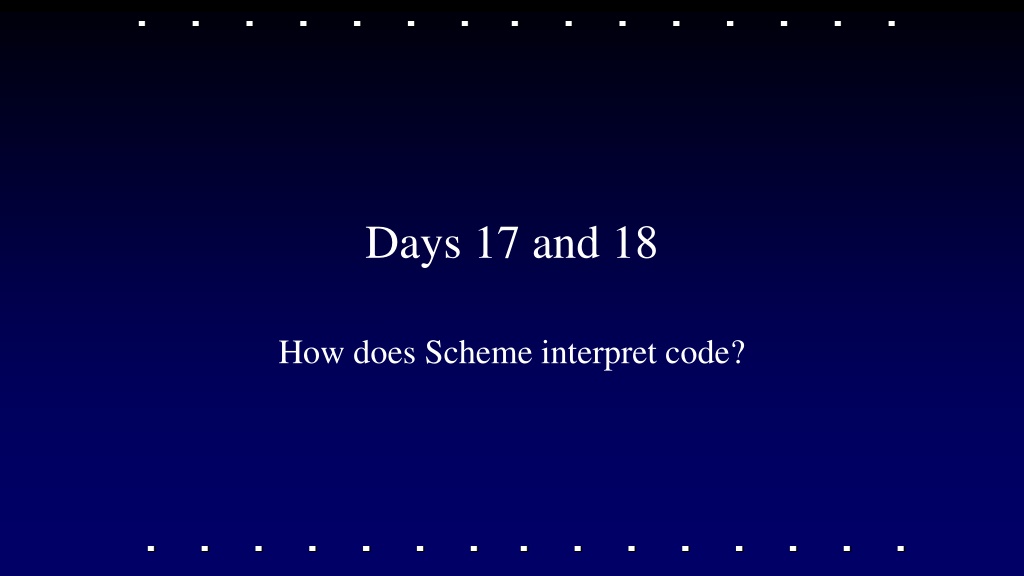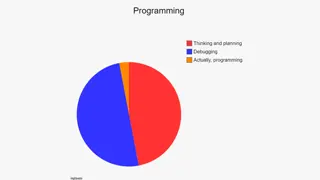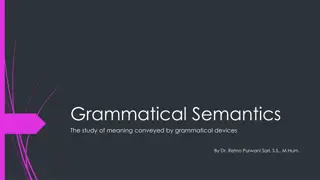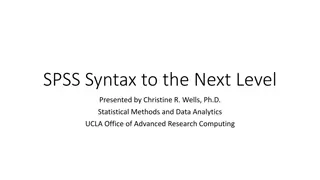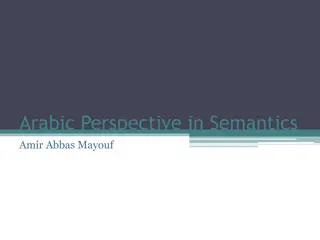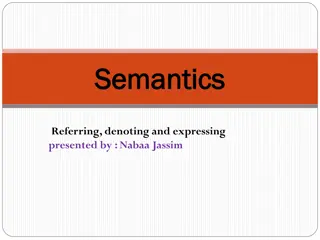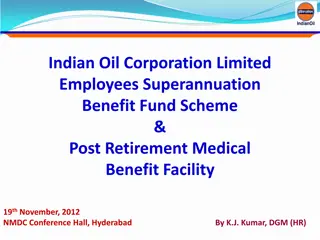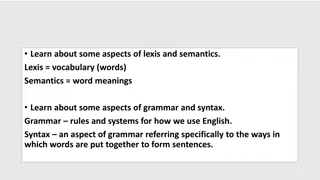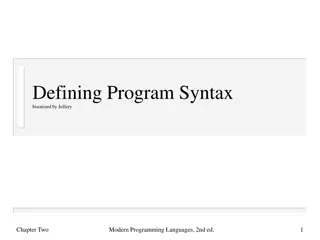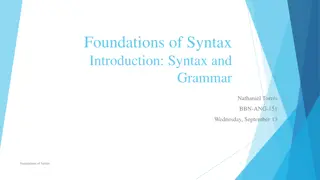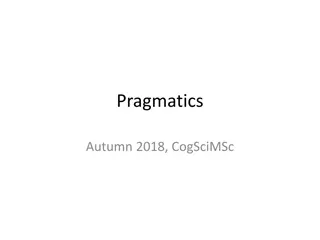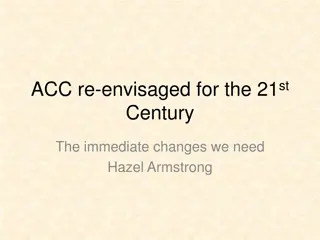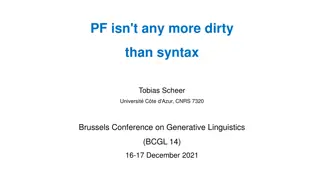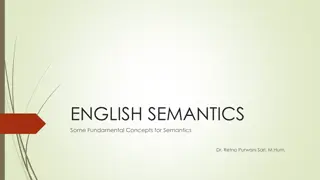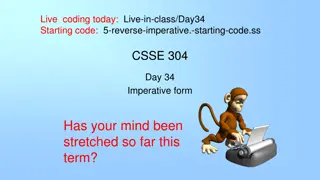Understanding Scheme's Execution Mechanism: Syntax, Semantics, and Environments
Dive into Scheme's interpretation of code, from representing syntax and semantics to implementing lexical scoping with first-class procedures. Explore the concept of variable bindings, environments, local environments, and procedures (closures) in Scheme's execution mechanism.
Download Presentation

Please find below an Image/Link to download the presentation.
The content on the website is provided AS IS for your information and personal use only. It may not be sold, licensed, or shared on other websites without obtaining consent from the author. Download presentation by click this link. If you encounter any issues during the download, it is possible that the publisher has removed the file from their server.
E N D
Presentation Transcript
Days 17 and 18 How does Scheme interpret code?
Syntax Semantics define-datatype and parse-exp give us a way to get from a concrete representation of program syntax to a more abstract one. Now we want to get the meaning (interpretation). How do we implement lexical scoping with first-class procedures? First question: How to represent the bindings of variables to data? (environments) We will spend a couple of class days taking an abstract look at this, then we will look at concrete implementations of environments
Some data structures behind Scheme's execution mechanism Don't allow yourself to get lost during today s class! Ask instead! ENVIRONMENTS AND CLOSURES (ABBREVIATED E&C)
Variable bindings and environments An environment is a table of variable names (symbols) and their associated values. The values are not code or pointers to other environments. a #t xyz "xyz" i j 4 7
Variable bindings and environments The global (top-level) environment is dynamic; symbols are added to the environment via define the values of symbols can be changed via set! However car proc is represented car + However + proc is represented
local environments When a lambda-defined procedure is applied to arguments (also when a let, let*, or letrecis executed), a new local environment is created to hold the bindings of the variables that are defined at that level. . . .
Evaluate a let expression Evaluate (in the current environment) the expressions to get the values to be assigned to the let variables. Create a new local environment with bindings for the let variables. Its "enclosing environment" pointer points to the current environment. Evaluate the body of the let in this new environment. > (define a 5) > (let ([z (+ a 3)] [t 7]) (let ([y (+ z a)]) (list a t z y))) a. b. c. However car proc is represented car + a However + proc is represented 5
Procedures (closures) When a lambda-expression is evaluated, what is returned? When does the body of a lambda-expression get evaluated? What kind of info needs to be stored in a procedure? What happens when a procedure is applied? (Answers on the next few slides)
Procedures (closures) Whenever a lambda expression is evaluated, a procedure (also known as a closure) is created A closure consists of three parts. Note that a lambda expression is not a procedure. What is it? Is the body of a lambda expression ever evaluated during the evaluation of the lambda?
Procedure application I will draw pictures here and verbally describe what is going on. Much of that verbal explanation also appears in writing on the next two slides. You should read them later. 1. 2. The expressions for the procedure and arguments are evaluated. A new local environment is created: Each variable from the procedure's formal parameter list is bound to the corresponding value from the actual argument list. The new environment's "pointer to an enclosing environment" is set to be a copy of the local environment pointer that is the third part of the closure. The body of the procedure is evaluated, using this new local environment. If a variable is not found in local environment, look in the global environment. Simple Example: car + 3. > (define add2 (lambda (car) (+ car 2))) > (add2 17)
Simple Example (define add2 (lambda (car) (+ car 2))) The evaluation of the lambda-expression produces a closure like this: Because the lambda-expression has no lexically- enclosing bindings, the environment pointer in this closure is null. The define adds an entry for add2 to the global environment, whose value is this procedure. Draw picture on the board
Simple Example (continued) What happens when the procedure is applied? (add2 17) First, the value of add2 is looked up in the (global) environment. The value of 17 is itself. Now we create a new local environment, binding the local variable car to the value 17. The enclosing environment pointer for this local environment is a copy of the closure's null environment pointer. Now we evaluate the body. There is no + in the local environment, and there is no enclosing environment, so we find + in the global environment. the value of car ( which is 17) is found in the local environment. 17 is added to 2 (primitive procedures such as + are applied without making any new environments). 1. 2. 3.
Diagram notation (use it!) A local environment has two parts: a table of bindings of variables to values (fixed number of entries) A pointer to the enclosing local environment A closure has three parts List of parameter names Code (the procedure's body) A pointer to the environment that was current when the closure was created.
A More Complex Example ((lambda (x) ((lambda (y) (+ x y)) 15)) 20) First, the outer lambda-expression is evaluated to produce this closure: What happens next?
Summary/Review questions 1. What happens when a lambda-expression is executed? 2. When is a new local environment created? 3. What is the initial value of the current local environment? 4. When we evaluate a let expression, to what does the "env pointer" in the new local environment point? 5. When we evaluate a lambda expression, to what does the "env pointer" in the resulting closure point? 6. When we apply a closure, where does the new local environment get its "enclosing env" pointer?
Summary/Review questions 1. What happens when a lambda expression is executed? A closure is created and returned 2. When is a new local environment created? When Scheme (a) executes a let (or letrec) or (b) applies a closure to arguments 3. What is the initial value of the current local environment? The empty environment 4. When we evaluate a let, to what does the "env pointer" in the new local environment point? The local environment that is current when we start to evaluate the let. 5. When we evaluate a lambda expression, to what does the "env pointer" in the resulting closure point? The local environment that is current when we start to evaluate the lambda. 6. When we apply a closure, where does the new local environment get its "enclosing env" pointer? A copy of the closure's environment pointer
An example with recursion The following three Scheme expressions are evaluated (in the order shown here): >(define fact (lambda (n) (fact2 n 1)) >(define fact2 (lambda (n acc) (if (zero? n) acc (fact2 (- n 1) (* n acc))))) >(fact 2) Draw a diagram showing all closures and local environments that are created during this execution (with arrows indicating when one of these objects contains a reference to another one). Use words to describe the process.
Example: Similar in complexity to A12 The following two Scheme expressions are evaluated (in the order shown here): >(define f (lambda (x) (let ([a (lambda (y z) (+ x y z))]) (lambda (b) (a (+ 5 b) x)))) >((f 3) 4) I show the details of this example in a video called Complex E&C example . Auxiliary procedure:
Evaluate letrec expressions a. Create a new local environment, similar to a let environment, except that: i. The enclosing environment" pointers of all closures that are bound to the letrec variables point to the new environment, not the enclosing environment. b. Evaluate the body of the letrec in this new environment.
Example with letrec >(define odd? (letrec ([odd? (lambda (n) (if (zero? n) #f (even? (- n 1))))] [even? (lambda (m) (if (zero? m) #t (odd? (- m 1))))]) (lambda (x) (odd? x)))) >(odd? 2)
Interlude Quote from Richard Feynman (1918-1988), Caltech physicist and Nobel Prize winner: There are 1011 stars in the galaxy. That used to be a huge number. But it's only a hundred billion. It's less than the national deficit! We used to call them astronomical numbers. Now we should call them economical numbers. What does a trillion dollars look like? https://www.youtube.com/watch?v=WBxWdD 9YKdY
